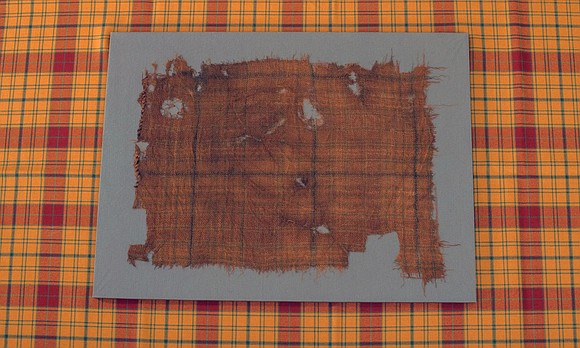Scotland’s oldest tartan, found in peat bog, now recreated and available to buy
CNN/Stylemagazine.com Newswire | 1/22/2024, 11:44 a.m.

Originally Published: 22 JAN 24 11:41 ET
Updated: 22 JAN 24 12:11 ET
By Amy Woodyatt, CNN
London (CNN) — Textile designers and tartan experts have banded together to recreate the oldest piece of Scottish tartan for modern production, allowing fans of the famed plaid to wear a piece of history.
Using carbon dating, scientists discovered that the “Glen Affric” fabric, uncovered in a peat bog in the Highlands during forestry work and donated to the Scottish Tartans Authority in the 1980s, dated back to around 1500-1600.
This, they said, makes it the oldest “true tartan” specimen in Scotland. Specialists could find no similarity with any known clan tartans, which were developed in the early 19th century.
Though the sample was stained by the peat, experts were able to identify green and brown or black stripes overlaid on one or two colors. Dye analysis on 8 samples from the historic piece then revealed it had also contained red and yellow.
Now, the pattern has been recreated for the modern wardrobe by tartan fabric creator and weaver House of Edgar.
Based on the dye analysis and pattern extraction from the original material, experts from the Scottish Tartans Authority, which preserves and promotes the origins, history, manufacture, use and development of the fabric, worked with House of Edgar to find shades that would work with the designers’ latest palette.
Peter Eslea MacDonald, head of research and collections at the Scottish Tartans Authority, told CNN via email that the teams worked together to “maintain the pattern and colours, but refining the shades to something that would have existed at the time but which also work today.”
“It was undoubtedly a status piece,” MacDonald said of the original fabric. “It is likely to have belonged to an important person, possibly a woman or a gentleman of rank,” he said, adding that it would probably have been worn as a shawl or an upper body wrap.
Emma Wilkinson, designer at House of Edgar, told CNN it was “a real privilege” to work with experts to recreate the tartan, which will be available to buy as part of the company’s new collection, “The Seventeen Eighty Three Collection.”
“Many kilt shops both in Scotland and around the world will have access to this tartan, so we urge anyone looking to see the Glen Affric recreation in person and have a beautiful kilt or accessory made in this tartan to reach out to their local kiltmakers,” she said.
The-CNN-Wire








